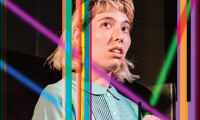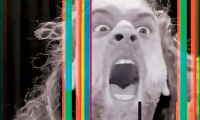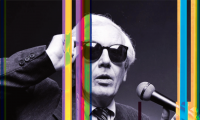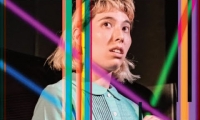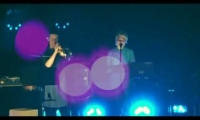LIQUID ROOM N°.10
WITH CONTRECHAMPS ENSEMBLE,
NINA GUO,
TAREK HALABY
VIDEO EXCERPT
WORKS
Robert Ashley
Tap dancing in the sand, 1982
Perfect Lives, Act 3: The Bank (Victimless Crime), 1983
The Indifference Text (from The Improvement), 1984-1990
Sarah Nemtsov
Implicated Amplification, 2014
Jessie Cox
The Drum is a Tree I
Re(mnants): of Woods and Skins
The Drum is a Tree II
(commissioned by Contrechamps & Ictus, 2024)
Laurie Anderson
O Superman, 1981
Tom Johnson
Rational Melody X
Rational Melody XV, 1982
Jennifer Walshe
Trí Amhrán (Three Songs), 2019,
Songs 1 and 3
Bryn Harrison
Five miniatures in three parts, 2008
VOICES
ICTUS
Anita Cappuccinelli, stage management
Tom De Cock, micro-percussion, drumkit
Antoine Delagoutte, sound assistant
Alexandre Fostier, sound
Caspar Langhoff, light design (Brussels)
Pak Yan Lau, electronic keyboards, Pianet
Aisha Orazbayeva, violin and vocoder
Jean-Luc Plouvier, electronic keyboard, Fender Rhodes
Susana Santos Silva, trumpet
Guillaume Toussaint, technical assistant
ENSEMBLE CONTRECHAMPS
Simon Aeschimann, guitar
Matthieu Baumann, light design (Genève)
Serge Bonvalot, tuba
Laurent Bruttin, clarinets
Hans Egidi, viola
Maximilian Haft, violin
Susanne Peters, flute
Charles Pierron, horn
PRODUCTION
Klarafestival
Kaaitheater
Ictus
Contrechamps
WITH THE SUPPORT OF
The Swiss Arts Council Pro Helvetia
Tax shelter of the Belgian federal government

THE LIQUID ROOM
… our pride and joy. These multistage and polystylistic events have been organized across Europe since 2009. In these festival-like events, audiences are encouraged to roam freely, come and go, sit on small cardboard stools or remain standing; they can switch from one stage to the next, alternating between different kinds of music and listening moods.
ROBERT ASHLEY
… is little-known yet renowned!
As you may recall, in 1983, Peter Greenaway made a prominent four-segment documentary called Four American Composers.
In addition to Philip Glass and John Cage, both eminent composers at the time, Greenaway’s subjective gaze also shed light on the importance of Meredith Monk and Robert Ashley in the development of American music. Today, we will particularly focus on Ashley’s oeuvre: elusive, and, in literary terms, undoubtedly the most ambitious of them all.
In the 1960s in Michigan, Ashley organized the acclaimed ONCE festival, a platform that presented and juxtaposed Fluxus style pieces with performances (Lucinda Childs, Steve Paxton), contemporary chamber music and punk (the festival saw the emergence of Iggy Pop and The Stooges). Ashley described his own style as ‘Music with Roots in the Aether’’, before it came to be known as ‘minimalist’ (1). Resulting from collective work, his oeuvre is a manifest of great creative freedom, and a far cry from the practices of classical-modernist opera.
__
(1) On the construction of this term, and the close semantic battle that accompanied it, see Christophe Levaux, We Have Always Been Minimalist
DAYDREAM
… or a ‘waking dream’: Ashley’s oeuvre in the 1980s is a prime stylistic example of what came to be known as the ‘postmodern’ moment.
“I don’t think there’s any heroism anymore”, said Ashley, resembling Andy Warhol in this respect. Case in point: Ashley’s paradoxical ‘operas’ did not have heroes but were instead based on individual narratives and populated by myriad characters from an archetypal Middle America.
Ashley suffered from a mild form of Tourette’s syndrome, which inspired him to produce an overabundance of involuntary sounds with varying degrees of significance. Based on this minor literature, he empirically established the three features of his inimitable style: the use of a microphone to capture highly subtle spoken intonations; a fascination with speed (“English doesn’t sound right when it’s slowed down”); and the aloofness of the perfect dandy.
The miracle was hence produced: the prose of non-heroic lives became Aethereal Music, altered states of consciousness. “I'm in a kind of daydream where I can hear words with music,” Robert Ashley declared.
A THEATRE OF VOICES
To leap into the heart of the matter, we have chosen to examine the most bountiful and enigmatic material Robert Ashley has ever produced: Perfect Lives, the 1983 seven-episode television opera directed by John Sanborn. Described as a journey through several quintessential places in the mental landscape of America — The Park, The Supermarket, The Church, The Bank — and the ordinary lives of those who inhabit them, the series, told in a distinctly American vernacular, puts great emphasis on video experimentation, and is generally considered a precursor of television productions ten years later.
Presented much in the same fashion as our novel version of Philip Glass’ opera Einstein on the beach — focused solely on the musicians at work — we will approach Ashley’s Perfect Lives *from a strictly musical and performative angle. We direct our attention on the *theatre of voices, creating thus new acoustic images of the body.
PARTNERS IN CRIME
With Perfect Lives as a backdrop, we also present a new take on Tap Dancing in The Sand, a more recent work by Robert Ashley, performed by the Swiss ensemble Contrechamps – our guests of honor for this new Liquid Room edition.
ABOUT JESSIE COX
Jessie Cox is a Black Swiss drummer, composer and researcher. He is currently completing a doctorate at Columbia University. He has worked with the Sun Ra Arkestra, Ensemble Modern and the JACK Quartet among others. His triptych that was specifically commissioned for this concert, is in its own way a part of our Theatre of Voices. It brings together two actors with paradoxical modes of existence: the songs of extinct species of birds and the so-called talking drum.
Jessie Cox:
“The Drum is a Tree and Re(mnants): of Woods and Skins are two pieces that engage the interrelated crises of the climate and of anti blackness through music as an opening for new possibilities towards unthought, and impossible, futures. The drum serves as a leading example and metaphor towards this possible refiguring of our futures. In its material constitution it is made of woods from trees and the skins of either cattle or wild animals. The devaluing and banning of drums, that accompanies forms of extinction such as colonialism, slavery, and capitalist exploitation, is reflected also in the destruction of the environments and lives – human and otherwise – that meet as/within/around the drums. The drum is also a sound, and like all those lives, life-forms, ways of living, ways of sounding, that get destroyed in these crises, its sound is in jeopardy. But, what might happen, when we music; when the sound of drums is valued again, and is changing how we come to value? Here, as those who are inheritors of survivors of multiple extinction events, we may rethink not only how we live in and with the world, but also what “we” may be.”
ABOUT JENNIFER WALSHE
In 2016, an international and informal network of composers published a series of short manifestos around the appellation New Discipline. These artists (James Saunders, David Helbich, Matthew Shlomowitz, Neele Hülcker, François Sarhan, Jessie Marino, Steven Takasugi, Natacha Diels, Jennifer Walshe, among others) described a series of traits in which a new generation of musical artists could be found: emphasizing the conceptual art way of thinking, focusing on ecological, decolonial and queer themes, shifting from "computer excellence" to all the popular forms of digital life as well as depending on temperament, humor, kitsch and "do-it-yourself" aesthetics. With Three Songs, the Irish composer Jennifer Walshe pursues the somewhat Borgesian project of an imaginary encyclopedia of Irish culture. Let's recall her fake documentaries on the great Irish Dada movement (that was completely imaginary). In Three Songs, she uses Artificial Intelligence to recreate synthetic folklore from scratch.
ABOUT TOM JOHNSON
A privileged witness to the American avant-garde of the 1970s thanks to his columns in the Village Voice - and thus co-responsible, with Michael Nyman, for the now-contested term "minimalism" - Johnson is also a composer with a very singular voice. Without ever using a machine, he has developed a radically elegant "handmade" algorithmic music. Each of his pieces is a musical response to a logical, mathematical or topological problem. Rational Melody X is a combinatorial system on 3 X 3 notes, and has the air of perfection similar to a Bach prelude. The even more ambitious Rational Melody XV constructs a fractal melody – read it as it is, or take only one note out of two, or four, or eight or sixteen...it will always be the same
melody.
ABOUT BRYN HARRISON
At a time when "minimalist style" is returning as the neo-hype art of our time, nothing is more refreshing than to delve into Bryn Harrison's strange repetitive systems. They have remained connected to the most powerful intuitions of the American avant-garde: transfiguring perception through the disorientation of memory.
Bryn Harrison:
“Exact repetition changes nothing in the object itself but does change something in the mind that contemplates it, these works deal explicitly with aspects of duration and memory through which near and exact repetition operate in close proximity throughout and provide points of orientation and disorientation for the listener.”
ABOUT SARAH NEMTSOV
Born in 1980, Sarah Nemtsov has developed an abundant and violent body of work (over 150 compositions!), in which electronics embody a restless dreamlike quality. She once wrote this about another work, which also perfectly describes the one heard today: "I wanted an earthy sound, with dust and dirt, mud, stones, organic matter from a soil other than the one we live on."
ABOUT LAURIE ANDERSON
O Superman is a part of the great multimedia cycle United States. This eight-hour show, composed and performed by Laurie Anderson, premiered in Brooklyn forty years ago, in 1983. It was a landmark of its time: at once monumental and ostensibly "bricolage", it is composed of video and still images, avant-garde and pop music, spoken text, gestural performance and playful electronics. The film of the show is now projected in a loop as part of the permanent collection at MoMA in New York.
O Superman is based on a subtle, poisonous poem that alternates between false leads and reversals. It opens with a delightful sense of humor: it seems that Superman's mother wants to check in and leave a message on her hero son's answering machine. Superman has to deal with a mother hen: what a romp! But "Mom's" voice soon changes its nature. It soon becomes The voice of all; The Voice – a disturbing figure of the Other, at once gentle, insinuating and anonymous: "Well, you don't know me, but I know you". On Superman's answering machine, The Voice then insists on leaving a very specific message: "So you better get ready,
ready to go | Here come the planes | They're American planes, made in America". The listener then understands that Mom's voice may be nothing more than the voice of America itself, the vague patriotism that remains "when justice is gone":
So hold me, Mom, in your long arms, in your automatic arms, your electronic arms, your petrochemical arms, your military arms.
GREETINGS
Thank you for coming to the Theatre of Voices! Come and talk to us at the end of the show, if you like, and don't take our precious stools with you!
DE LIQUID ROOM
... onze trots en vreugde ! Mensen komen en gaan, zitten op kleine krukjes of blijven rechtstaan. Het geheel heeft iets van een festival waarin snel geschakeld wordt van de ene scène naar de andere scène, met muziek van uiteenlopende stijlen die uitnodigt tot verschillende manieren van luisteren.
Een festival-concept te zien door heel Europa sinds 2009.
ROBERT ASHLEY,
de illustere onbekende…
Ter herinnering: in 1983 realiseerde Peter Greenaway de spraakmakende vierdelige documentaire ‘Four American Composers’.
Naast Philip Glass en John Cage, toen allebei reeds eminente componisten, wees de film op het belang van Meredith Monk en Robert Ashley voor de ontwikkeling van de Amerikaanse muziek. Het is Ashley die ons vandaag de dag fascineert met zijn ongrijpbare werk, op literair gebied allicht het meest ambitieuze van allemaal.
Als bezieler van het beroemde Once Festival, dat het licht zag in de jaren 1960 in Michigan, slaagde Ashley erin een platform te creëren waar de geest van Fluxus, performancekunst (Lucinda Childs, Steve Paxton), hedendaagse kamermuziek en punk (de Stooges van Iggy Pop speelden er in hun meest embryonale vorm) naast elkaar bestonden. Hij noemde zijn eigen stijl ‘Music with Roots in the Aether’, voordat de term ‘minimal music’ ook voor zijn muziek werd gebruikt (1) . Als resultaat van een collectief proces, is zijn werk een appel aan creatieve vrijheid, ver verwijderd van de aanpak in de klassieke-modernistische opera.
__
(1) Cfr Christophe Levaux, We Have Always Been Minimalist
DAYDREAM
Dagdroom. Ashley's werk uit de jaren 1980 staat met een zekere stilistische perfectie symbool voor wat men later als het ‘postmoderne momentum’ is gaan bestempelen.
"Ik denk dat er nauwelijks nog sprake is van een heroïsme", aldus Ashley - een uitspraak die hem dichter bij Andy Warhol brengt. En inderdaad, er zijn geen helden in deze paradoxale opera's, enkel individuele verhalen, een veelheid aan kleine personages uit een archetypisch Midden-Amerika.
Ashley beweerde ook dat hij aan een lichte vorm van het syndroom van Gilles de la Tourette leed, waardoor hij een onwillekeurige, voortwoekerende stroom van woorden produceerde met veel betekenisniveaus. Op basis van dit eigenzinnige schrijverschap stelde hij empirisch de drie elementen van zijn onnavolgbare stijl vast: het gebruik van de microfoon om de subtielste intonaties van de gesproken stem op te vangen, een cultus van de hoge snelheid ("Engels klinkt niet goed als het wordt vertraagd", zei hij altijd) en tot slot, de onverschillige houding van de perfecte dandy.
Dan gebeurt het wonder: het proza van de levens van niet-helden gaat over in Aethereal Music, met veranderde bewustzijnstoestanden. "Ik projecteer mezelf in een soort dagdroom als ik het gesproken woord op muziek hoor", zei Robert Ashley.
A THEATRE OF VOICES
Om direct tot de kern van de zaak te komen, besloten we ons te verdiepen in het rijkste en meest iconische materiaal van Robert Ashley: zijn zevendelige televisieserie ‘Perfect Lives’, geproduceerd in 1983 met videokunstenaar John Sanborn.
Deze serie wordt beschreven als een wandeling door een aantal hoogtepunten van het Amerikaanse mentale landschap (het Park, de Supermarkt, de Kerk, de Bank) en door het gewone leven van de inwoners. De puurste Amerikaanse volkstaal wordt hierin vastgelegd. De reeks, waarin video-experimenten de hoofdrol spelen, wordt algemeen beschouwd als een voorloper van wat de televisie tien jaar later zou ontwikkelen.
Maar net zoals we onlangs een nieuwe versie van Philip Glass' opera Einstein on the Beach presenteerden, waarbij we ons uitsluitend concentreerden op het spektakel van musici ‘aan het werk’, benaderen we Ashleys Perfect Lives vanuit een strikt muzikale en performatieve invalshoek. We richten ons op het theater van de stemmen en de productie van nieuwe akoestische beelden van het lichaam.
PARTNERS IN CRIME
Als neventhema presenteren we een nieuwe lezing van Tap Dancing in The Sand, een meer recent, gecomponeerd werk van Robert Ashley, uitgevoerd door het Zwitserse ensemble Contrechamps, onze eregasten voor deze nieuwe Liquid Room.
OVER JESSIE COX
Jessie Cox is een Amerikaans-Zwitserse Afro-Amerikaanse drummer, componist en onderzoeker. Hij is bezig met een doctoraat aan Columbia University. Hij heeft gewerkt met het Sun Ra Arkestra, het Ensemble Modern en het JACK Quartet. Zijn speciaal voor dit concert bestelde drieluik maakt op zijn eigen manier deel uit van ons Theatre of Voices, door stem te geven aan twee acteurs met paradoxale bestaanswijzen: het gezang van uitgestorven vogelsoorten en de talking drum.
Dit is wat de componist over deze stukken te zeggen heeft:
"The Drum is a Tree en Re(mnants): of Woods and Skins zijn twee stukken die door middel van muziek de onderlinge verbondenheid van de klimaatcrisis en anti-zwart racisme aan de kaak stellen. De functie van muziek is hier om ons open te stellen voor nieuwe mogelijkheden, voor toekomsten die nog niet bedacht en vooralsnog onmogelijk zijn. De drum dient als model en metafoor voor deze mentale herconfiguratie. In zijn materiële vorm is de trommel gemaakt van hout en de huiden van runderen of wilde dieren. De devaluatie en het verbod op trommels, die gepaard gingen en nog steeds gaan met vormen van uitroeiing zoals kolonialisme, slavernij en kapitalistische uitbuiting, vinden hun analogie in de vernietiging van onze omgeving en ons leven, zowel menselijk als niet-menselijk. De trommel is ook een levend geluid en net als alle levens, kristallisaties van leven, manieren om in de wereld te zijn en de wereld te laten klinken die door deze crises worden vernietigd, vertelt het geluid van de trommel ons dat het in gevaar is. Maar wat zou er kunnen gebeuren als we er weer op zouden spelen, als het geluid van de trommel weer gewaardeerd zou worden en we de waarde die we eraan hechten zou veranderen ? Als erfgenamen van de overlevenden van meerdere uitstervingen krijgen we de kans om niet alleen opnieuw na te denken over hoe we de wereld bewonen en met de wereld leven, maar ook over wat we met dit wij kunnen doen."
OVER JENNIFER WALSHE
In 2016 publiceerde een informeel internationaal netwerk van componisten een reeks korte manifesten onder de vlag van de ‘New Discipline’. Deze kunstenaars (o.a. James Saunders, David Helbich, Matthew Shlomowitz, Neele Hülcker, François Sarhan, Jessie Marino, Steven Takasugi, Natacha Diels en Jennifer Walshe) hadden een en ander gemeen: een benadering verwant aan de conceptuele kunst, productie van werk over ecologische, decoloniale en queer thema's; de transitie van "excellentie op het gebied van informatica" naar aandacht voor alle populaire vormen van het digitale leven; en, afhankelijk van het temperament van de kunstenaar met nadruk op humor, kitsch of de esthetiek van de "doe-het-zelver".
Met 'Three Songs' streeft Jennifer Walshe, van Ierse afkomst, het enigszins Borgesiaanse project na van een denkbeeldige encyclopedie van de Ierse cultuur. We denken aan haar nep documentaires over een grote Ierse Dada-beweging, totaal denkbeeldig. In 'Three Songs' gebruikt ze kunstmatige intelligentie om een synthetische folklore uit het niets te creëren.
OVER TOM JOHNSON
Als bevoorrechte getuige van de Amerikaanse avant-garde van de jaren 1970 via zijn columns in de Village Voice - en dus samen met Michael Nyman verantwoordelijk voor de nu omstreden term 'minimalisme' - is Johnson ook een componist met een heel eigen stem. Zonder ooit een machine te hebben gebruikt, heeft hij een radicaal elegante 'ambachtelijke' algoritmische muziek ontwikkeld. Elk van zijn stukken is een muzikaal antwoord op een logisch, wiskundig of topologisch probleem. Rational Melody X is een systematische combinatie van 3 x 3 noten, met het parfum van perfectie van een Bach prelude. Meer ambitieus, construeert hij in de Rational Melody XV een fractale melodie (lees het zoals het is, of met slechts één noot uit twee, of vier, of acht of zestien...): het is altijd dezelfde melodie.
OVER BRYN HARRISON
In een tijd waarin de 'minimalistische stijl' het neo-academisme van onze tijd aan het worden is, is er niets verfrissender dan terug te kijken naar de vreemde repetitieve systemen van Bryn Harrison, die verbonden blijven met de krachtigste intuïties van de Amerikaanse avant-garde: het transformeren van de waarneming door het geheugen te desoriënteren. Bryn Harrison: "Pure herhaling verandert niets aan het object zelf, maar wel iets aan de geest die erover nadenkt. [Mijn] werken houden zich expliciet bezig met aspecten van duur en geheugen, waarbij herhaling ‘bij benadering’ en identieke herhaling nauw samenwerken om de luisteraar punten van oriëntatie en desoriëntatie te bieden."
OVER SARAH NEMTSOV
Sarah Nemtsov, geboren in 1980, heeft een rijk en heftig oeuvre ontwikkeld (meer dan 150 composities!), waarin elektronica vaak in dienst staat van een rusteloze droomwereld. Over een ander werk, dat perfect aansluit bij dat van vandaag, schreef ze ooit het volgende: "Ik wilde een aards geluid, met stof en vuil, modder, stenen, organisch materiaal van een andere bodem dan die waarop wij leven".
OVER LAURIE ANDERSON
O Superman maakt deel uit van de grote multimediacyclus United States. Deze acht uur durende show, gecomponeerd en uitgevoerd door Laurie Anderson, werd veertig jaar geleden, in 1983, gecreëerd in Brooklyn. Het heeft zijn tijd gemarkeerd: tegelijk monumentaal en ogenschijnlijk 'bricolage', bestaat het uit video's en stilstaande beelden, avant-garde en popmuziek, gesproken tekst, gebarenperformance en speelse elektronica. De film van de show wordt nu in een loop geprojecteerd als onderdeel van de permanente collectie in het MoMA in New York.
O Superman is gebaseerd op een subtiel, giftig gedicht dat afwisselend valse pistes en plotwendingen bevat. Het opent met een heerlijk gevoel voor humor: het lijkt erop dat de moeder van Superman hem wil controleren en een bericht wil achterlaten op het antwoordapparaat van haar zoon. Superman krijgt te maken met een helikoptermoeder: het kan verkeren! Maar de stem van "Mama" verandert al snel van aard. Het wordt al snel The Voice, een verontrustende figuur van de Ander, tegelijkertijd zachtaardig, insinuerend en anoniem: "Nou, jij kent mij niet, maar ik ken jou". Op het antwoordapparaat van Superman staat De Stem er vervolgens op om een zeer specifieke boodschap achter te laten: "Maak je klaar, de vliegtuigen komen eraan (Hier komen de vliegtuigen), de Amerikaanse vliegtuigen". De luisteraar begrijpt dan dat de stem van Mama misschien niets meer is dan de stem van Amerika zelf, het vage patriottisme dat overblijft "wanneer gerechtigheid weg is":
So hold me, Mom, in your long arms, in your automatic arms, your electronic arms, your petrochemical arms, your military arms.
GREETINGS
Bedankt voor uw komst naar het Theatre of Voices! Kom met ons praten aan het einde van de voorstelling, als je wilt, en neem onze kostbare krukjes niet mee!
LIQUID ROOM,
... ou « chambre liquide » , ce sont ces soirées multi-podiums et poly-stylistiques que nous donnons depuis 2009 dans toute l’Europe. Vous pouvez aller et venir, vous asseoir sur les petits tabourets ou rester debout. Nous passerons d’une scène à l’autre sans transition, alternant différents types de jeu, qui convoquent différents types d’écoute.
ROBERT ASHLEY,
... c'est l’inconnu célèbre !
Rappelez-vous : en 1983, Peter Greenaway réalisait un important documentaire en quatre parties, très engagé subjectivement , intitulé Four American Composers.
Aux côtés de Philip Glass et John Cage, tous deux déjà très célèbres à ce moment, le film pointait l'importance de Meredith Monk et de Robert Ashley dans le développement de la musique américaine. C'est ce dernier nom qui nous arrête aujourd’hui, ainsi que son œuvre insaisissable, littérairement sans doute la plus ambitieuse de toutes.
Animateur du fameux Once Festival, qui vit le jour dans le Michigan dans les années 1960, Ashley a réussi à créer une plateforme où cohabitaient et rivalisaient l’esprit Fluxus, la performance (Lucinda Childs, Steve Paxton), la musique de chambre contemporaine et le punk (on a pu y voir passer les Stooges d'Iggy Pop, dans leur forme embryonnaire). Il nommait son propre style en germe « Music with Roots in the Aether », avant que ne l’emporte l'appellation « minimaliste » (1). Dans la construction de son œuvre, Ashley a témoigné d’une grande liberté, au fil d’un travail mené collectivement, très éloigné des modes de travail de l’opéra classico-moderniste .
__
(1) Sur la construction de ce terme, et la passionnante bataille sémantique qui l'a accompagnée, voir le livre de Christophe Levaux, We Have Always Been Minimalist
DAYDREAM,
... ou "rêve éveillé".
L'œuvre d'Ashley des années 1980 offre, avec une certaine perfection stylistique, le meilleur témoignage de ce que l'on a pu appeler le moment “postmoderne”.
“Je pense qu'il n'y a plus guère d'héroïsme”, disait Ashley — une déclaration qui le rapproche d'Andy Warhol. Et en effet : pas de place pour le Héros dans ces “opéras” paradoxaux, mais des récits individuels, une myriade de petits personnages issus d’une Middle America archétypale.
Ashley se prétendait par ailleurs atteint d'un léger syndrome de Tourette, qui lui faisait produire une surabondance de paroles involontaires, proliférantes, avec de nombreux niveaux de signification. C'est à partir de cette littérature mineure qu'il a empiriquement établi les trois éléments qui ont réglé son inimitable style : l'usage du microphone qui capte les plus subtiles intonations de la voix parlée ; une culte pour la haute vitesse (“l'anglais ne sonne pas bien s’il est ralenti”, disait-il) ; et enfin, l'attitude indifférente du parfait dandy.
Alors, le miracle se produit : la prose des vies non-héroïques se transcende en Aethereal Music, en états modifiés de conscience. “Je me projette dans une sorte de rêve éveillé lorsque j’entends la parole placée sur de la musique”, disait Robert Ashley.
A THEATRE OF VOICES
Pour aller directement au vif du sujet, nous avons décidé de nous lancer dans le matériel le plus riche et le plus emblématique produit par Robert Ashley : sa série télévisée en sept parties, Perfect Lives, produite en 1983 avec le vidéaste John Sanborn.
Décrite comme une promenade sur quelques hauts lieux du paysage mental américain — le Parc, le Supermarché, l'Église, la Banque — et sur les vies ordinaires de ses habitants, capturant la plus pure langue vernaculaire américaine, cette série qui fait la part belle à l’expérimentation vidéo est généralement considérée comme un précurseur de ce que développera l'art télévisuel dix ans plus tard.
Mais, tout comme nous avons récemment proposé une nouvelle version de l'opéra de Philip Glass, Einstein on the beach, en nous concentrant sur le seul spectacle des musiciens au travail, nous abordons Perfect Lives d'Ashley sous un angle strictement musical et performatif, en mettant l'accent sur le théâtre des voix, en tant qu’il produit de nouvelles images acoustiques du corps.
PARTNERS IN CRIME
À partir de ce canevas, nous proposerons en contrepoint des œuvres plus récentes, plus “composées” de Robert Ashley, interprétées par l'ensemble suisse Contrechamps, nos invités d'honneur pour cette nouvelle Liquid Room.
SUR JESSIE COX
Jessie Cox est un batteur, compositeur et chercheur suisse afrodescendant. Il termine un doctorat à la Columbia University. Il a travaillé avec le Sun Ra Arkestra, l'Ensemble Modern, le JACK Quartet. Son tryptique, spécialement commissionné pour ce concert, s'inscrit à sa manière dans notre Théâtre des Voix en faisant parler deux acteurs aux modes d'existence paradoxaux : des oiseaux d'espèces récemment disparues, dont il nous reste l’enregistrement des chants ; et le talking drum — ou tambour à parole.
Voici ce que le compositeur dit de ces pièces :
« The Drum is a Tree et Re(mnants) : of Woods and Skins sont deux pièces qui abordent, par le biais de la musique, l’interconnexion de la crise climatique et du racisme antinoir. La fonction de la musique, ici, est de nous ouvrir à de nouvelles possibilités, des avenirs impensés et encore impossibles. Le tambour sert de modèle et de métaphore à cette reconfiguration mentale. Dans son être matériel même, le tambour est fait de bois et de peaux de bétail, ou d'animaux sauvages. La dévalorisation et l'interdiction des tambours, qui ont accompagné et accompagnent toujours ces formes d'extinction que sont le colonialisme, l'esclavage et l'exploitation capitaliste, trouvent leur analogie dans la destruction de nos environnements et de nos vies, humaines comme non humaines. Le tambour, c’est aussi un son vivant et — comme toutes les vies, les cristallisations de vie, les manières d’être au monde et de faire sonner le monde que ces crises anéantissent — le son du tambour nous dit qu’il est en danger. Mais que pourrait-il se passer si nous le musiquions à nouveau, si le son des tambours était à nouveau valorisé et que nous changions la valeur à lui accorder ? En tant qu'héritiers des survivants d'événements de multiples extinctions, il nous est donné de repenser, non seulement la façon dont nous habitons le monde et vivons avec le monde, mais aussi ce nous pouvons faire de ce nous. »
SUR JENNIFER WALSHE
En 2016, un réseau international et informel de compositeurs publiait une série de courts manifestes autour de l’appellation New Discipline. Ces artistes (James Saunders, David Helbich, Matthew Shlomowitz, Neele Hülcker, François Sarhan, Jessie Marino, Steven Takasugi, Natacha Diels, Jennifer Walshe, entre autres) décrivaient une série de traits où se retrouvait une nouvelle génération d’artistes musiciens : entrée en force des modes de pensée de l’art conceptuel ; travail autour des problématiques écologiques, décoloniales et queer ; le passage de « l’excellence informatique » à toutes les formes populaires de la vie digitale ; et éventuellement et selon les tempéraments, l’humour, le kitsch, l’esthétique du bricolage. Jennifer Walshe, d’origine irlandaise, poursuit avec les « Three Songs » le projet un peu borgésien d’une encyclopédie imaginaire de la culture irlandaise. On se souvient de ses faux documentaires sur un grand mouvement Dada irlandais, parfaitement virtuel. Dans les « Three Songs », elle s’aide de l’Intelligence Artificielle pour recréer de toutes pièces un folklore de synthèse.
SUR TOM JOHNSON
Témoin privilégié de l'avant-garde américaine des années 1970, dont témoignent ses chroniques dans le Village Voice — et par là co-responsable, avec Michael Nyman, de l'appellation "minimalisme" aujourd'hui contestée —, Johnson est aussi un compositeur à la voix tout à fait singulière. Sans jamais s'aider de la moindre machine, il a mis au point une musique algorithmique "faite main" d'une radicale élégance. Chacune de ses pièces répond, en toute musicalité, à un problème logique, mathématique ou topologique. La Rational Melody X est une combinatoire systématique sur 3 X 3 notes, et elle a le parfum de perfection d'un prélude de Bach. Plus ambitieuse, la Rational Melody XV construit une mélodie fractale (lisez-la telle quelle, ou en ne prenant qu'une note sur deux, ou sur quatre, ou sur huit ou seize... : c'est toujours la même mélodie).
SUR BRYN HARRISON
À l'heure où le "style minimaliste" est en passe de devenir l'art néo-pompier de notre temps, rien n'est plus rafraîchissant que de se plonger dans les étranges systèmes répétitifs de Bryn Harrison, qui sont restés connectés aux plus puissantes intuitions des avant-gardes américaines (nous pensons par exemple à Morton Feldman) : transfigurer la perception par la désorientation de la mémoire.
Bryn Harrison :
"La répétition pure ne change rien à l'objet lui-même, mais change quelque chose à l'esprit qui le contemple. [M]es œuvres traitent explicitement des aspects de la durée et de la mémoire à travers lesquels la répétition approximative et la répétition à l'identique s'unissent, tout du long, en étroite complicité, pour fournir à l'auditeur des points d'orientation et de désorientation."
SUR SARAH NEMTSOV
Née en 1980, Sarah Nemtsov a développé une oeuvre abondante et violente (déjà plus de 150 compositions !), où l'électronique, bien souvent, se met au service d'un onirisme inquiet. Elle écrivait un jour ceci au sujet d'une autre partition, qui collera parfaitement à celle d'aujourd'hui : "Je voulais un son terreux, avec de la poussière et de la saleté, de la boue, des pierres, une matière organique d’un autre sol que celui sur lequel on vit."
SUR LAURIE ANDERSON
O Superman fait partie du grand cycle multimedia United States. Ce spectacle long de huit heures, composé et interprété par Laurie Anderson, a été créé à Brooklyn il y a déjà plus de quarante ans, en 1983. Il a marqué son temps : à la fois monumental et ostensiblement bricolé, il est composé de vidéos et d’images fixes de type PowerPoint, de musique d’avant-garde et de pop, de textes parlés, de performance gestuelle et d’électronique ludique. Le film du spectacle est aujourd’hui projeté en boucle dans le cadre de la collection permanente du MoMA à New York.
O Superman s’appuie sur un subtil et vénéneux poème alternant les fausses pistes et les retournements. Il s’ouvre avec un humour délicieux : il semble que la mère de Superman veuille prendre des nouvelles et laisser un message sur le répondeur automatique de son héros de fils. Superman a affaire a une mère-poule : c’est un ressort comique ! Mais la voix de « Mom » change rapidement de nature. Elle devient bientôt La Voix tout court, The Voice, une inquiétante figure de l’Autre, à la fois douce, insinuante et anonyme : « Well, you don't know me, but I know you ». Sur le répondeur de Superman, The Voice insiste ensuite pour laisser un message bien précis : « Prépare-toi, les avions arrivent (Here come the planes), les avions américains ». L’auditeur comprend alors que la voix de Mom n’est peut-être rien d’autre que la voix de l’Amérique elle-même, le vague patriotisme qui demeure « lorsque la justice s’en est allée » :
So hold me, Mom, in your long arms, in your automatic arms, your electronic arms, your petrochemical arms, your military arms.
ENVOI
Merci d’être venu.e.s au Théâtre des Voix ! Venez nous parler à la fin du show, si vous le voulez, et n’emportez pas nos précieux tabourets !

